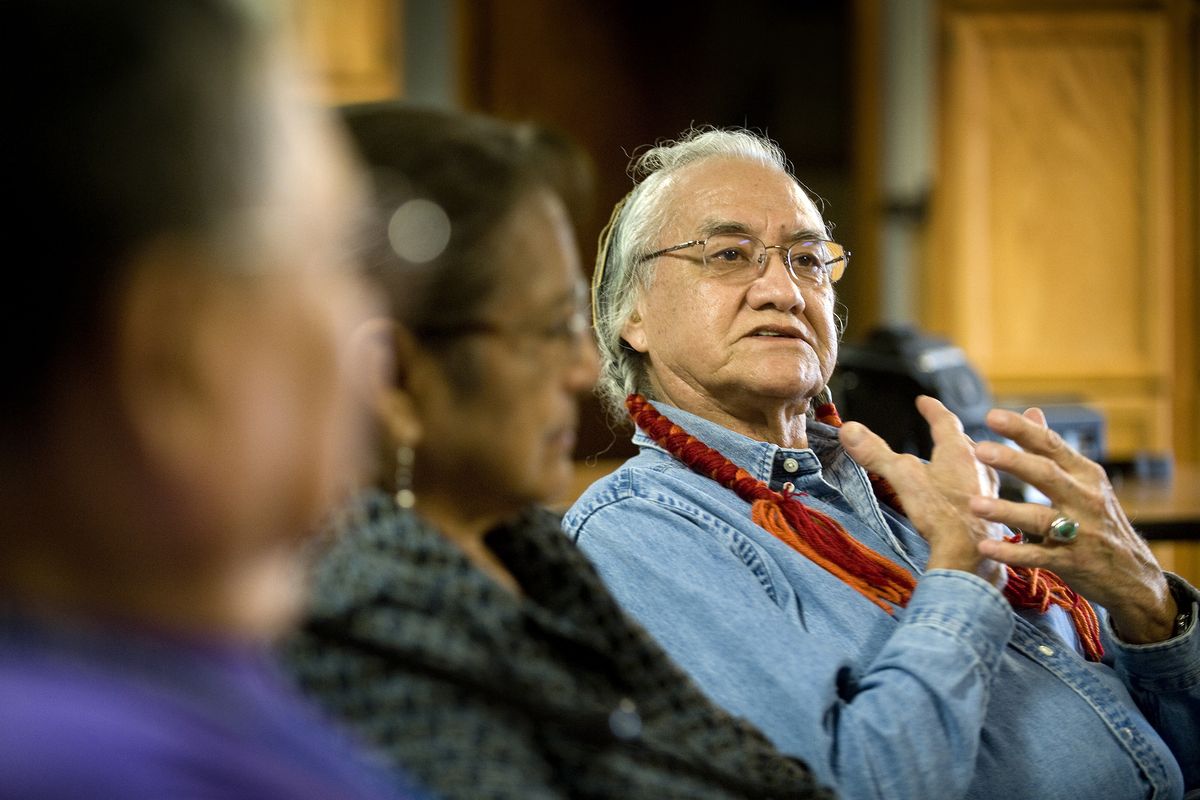Tribal program is saving Salish

USK, Wash. – For the first time in a couple generations, young people are speaking ancient words of hope for Native Americans on the brink of losing the first language of the Inland Northwest. Thanks to an innovative language acquisition program, Salish is being spoken on the Kalispel Indian Reservation in northeastern Washington, not just by a dwindling number of tribal elders but by their grandchildren and great-grandchildren.
“Our language is what holds us. It is a part of who we are. This is what my father told me,” said Dakota Littlecrow, who – at 17 years old – is well on her way to becoming fluent in Kalispel Salish.
The Kalispel and several other Interior Salish-speaking tribes from throughout the northwestern United States and southwestern Canada will share the lessons they have learned at the Inter-tribal Native Language Conference this week at the Northern Quest Resort and Casino.
Efforts to preserve Interior Salish – once spoken from Vernon, B.C., to Vantage, Wash., and from Wenatchee to Montana’s Bitterroot Valley – have become more critical as tribal elders grow fewer.
The Kalispel Tribe of about 400 people has lost 10 or 15 native Salish speakers in the past 10 years.
“Our elders are passing on,” said Francis Cullooyah, a Kalispel elder who is one of perhaps four surviving native speakers of Kalispel Salish in Washington state. “Those who knew the language really well are mostly gone today.”
Kalispel, Pend Oreille and Bitterroot Salish are considered one language, of which there are believed to be 52 surviving native speakers on Montana’s Flathead Indian Reservation, according to the Center for Interior Salish. Spokane Salish, a closely related dialect, has only a handful of native speakers remaining.
There are an estimated 175 native speakers of Colville-Okanogan in British Columbia and 25 in the United States.
Wenatchee-Moses Columbian is spoken fluently by perhaps five people, making it one of the most endangered languages in the world. More endangered is Coeur d’Alene, with only one or two native speakers remaining.
Although the Salish-speaking tribes have struggled for years to save their dialects, the separate efforts have achieved varying degrees of success, according to those involved in language preservation.
“We were spinning our wheels for a number of years,” Cullooyah said. “Fortunately, the Kalispel Tribe, through the efforts of some of our young people and elders are at the point we are today.”
J.R. Bluff, 44, assistant director of culture for the Kalispel Tribe and the son of a native Salish speaker, has worked for nearly eight years to learn and teach his father’s language.
“In the past, there were many attempts to get the language going,” Bluff said. “Ever since I was a kid it was important to my parents and my grandparents. I tried different things without much success.”
Bluff mentioned his struggle to a member of his drum circle, LaRae Wiley of the Colville Confederated Tribes, who also had tried to learn and teach Salish.
Wiley asked her husband, Chris Parkin, then a Spanish teacher at Gonzaga Prep, how he was able to teach his students to speak a second language. So he observed her course of study with another local tribe.
“She brought me in and I saw,” Parkin said. “They were inventing everything the day of (the lesson).”
What Wiley needed was a curriculum and prepared materials to allow a sequenced and efficient plan of instruction, Parkin believed.
Wiley and Parkin sold their home in Chewelah and moved to the Ashnola Indian Reserve in British Columbia, where they studied Colville- Okanogan Salish for a year under the tutelage of Sarah Peterson of the Lower Similkameen Indian Band.
They returned to Washington with a comprehensive curriculum, including texts and computer software. Together they founded the nonprofit Center for Interior Salish dedicated to preserving and revitalizing the language.
At the center’s direction, the Kalispel language program is focusing its efforts on transmitting the knowledge of the few surviving native speakers to a group of new, fluent speakers. Those new speakers in turn will pass the language on to children in the Cusick, Wash., public schools.
For now, the Kalispel language program has suspended its instruction in kindergarten through junior high while the staff members learn the new curriculum and immerse themselves in conversational Salish with native speakers.
These speakers include Bertha Covington, 72, a Sanpoil from the Colville Confederated Tribes; Johnny Arlee, 69, of the Confederated Salish and Kootenai Tribes of the Flathead Reservation in Montana; Louise Bowman, 80, and Stan Bluff, 67, both of the Kalispel Tribe.
Meanwhile, some of these elders are translating Kalispel stories – collected in English in the 1930s by Washington State University cultural anthropologist Allan Smith – back into Kalispel Salish. These stories are then illustrated by tribal artists and used to teach Salish in school.
One morning last week, these elders exchanged stories in Salish with new speakers from the Kalispel Tribe – including Jessie Fountain, 22, and Victoria Bowman, 45.
In the afternoon, Fountain and Bowman taught at Cusick High, where Littlecrow thumbed through illustrations of “Mosquito’s Story” while she told the story in Salish.
“Mosquito had five brothers,” she spoke in the language of her ancestors. “His brothers were very mean … .”
J.R. Bluff said his goal is to have 30 new Kalispel Salish speakers within five years. The $500,000-a-year language program is made possible because of revenue generated by the tribe’s Northern Quest Resort and Casino in Airway Heights.
“We’ve all been taught how important this is to our people, so it’s not much of a sale,” Bluff said. “Our language is our connection to those who walked this path before.”